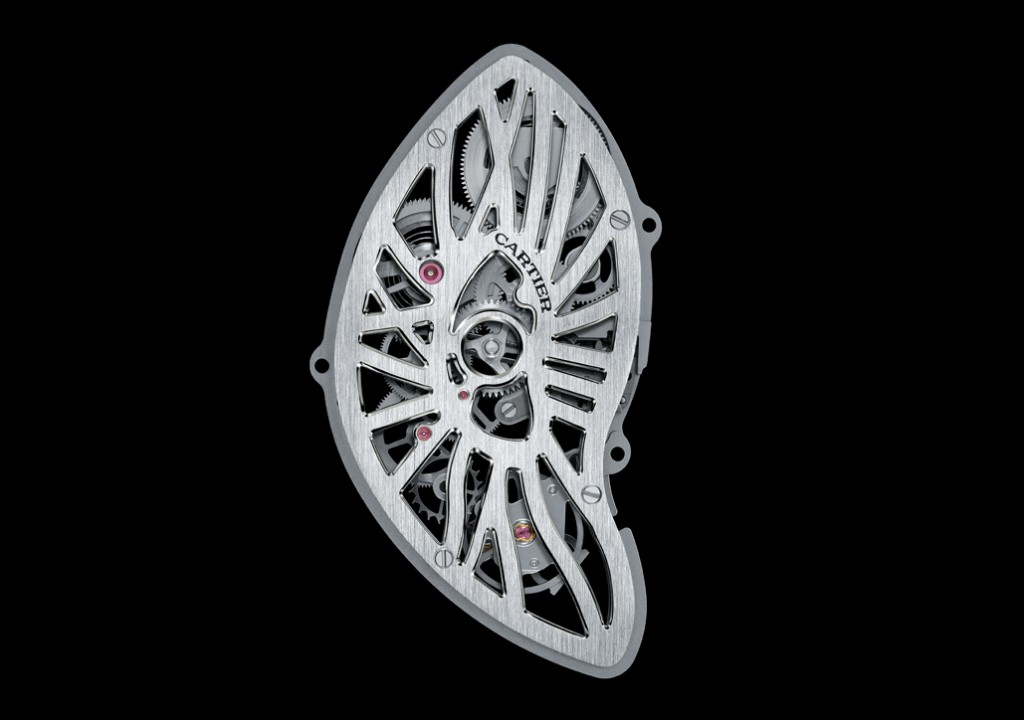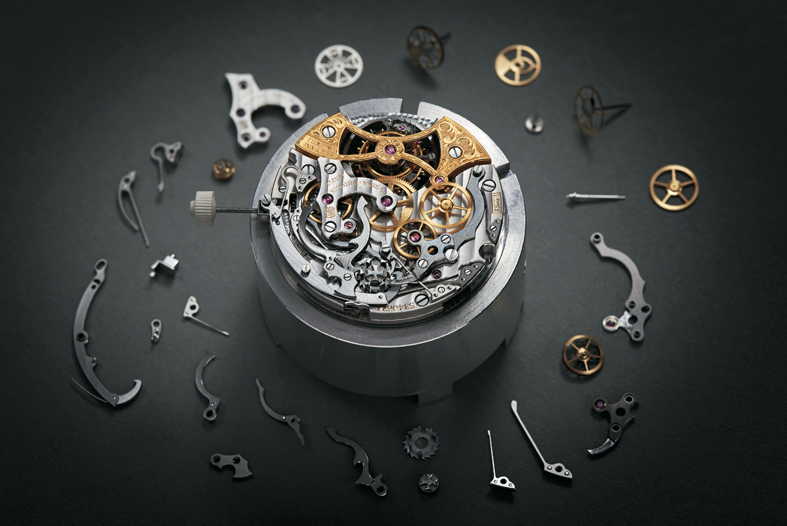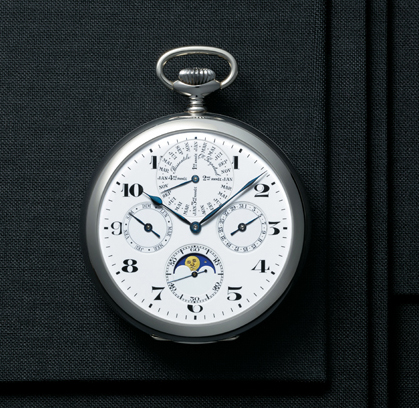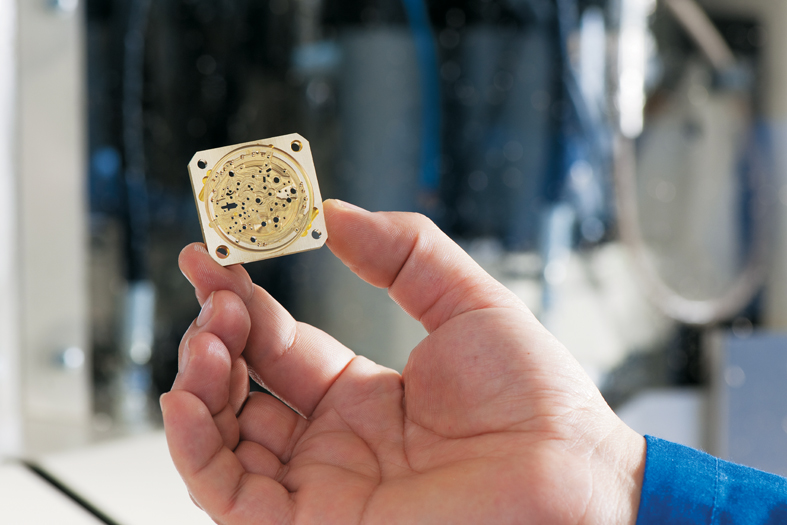Prestige watches guide, July-August 2015
Prepared by MARIA NADIM
The movement of the Crash Skeleton watch by Cartier. © Cartier
Automaton: (pl. automata) Machine, generally worked by clockwork, which sets in motion figures of men, animals, etc.
Aventurine: Artificial stone made by mixing copper fillings with quartz or fused glass.
Balance: Device which, by oscillating, regularizes the movement of the train of a watch or clock. In modern watch making balances are almost exclusively circular and monometallic (brass, German silver or glucinum bronze). In the past an infinite number of shapes and combinations of metals have been used in the manufacture of balances.
Carriage: In a tourbillon, the rotating frame that carries the escapement and the balance.
Perpetual calendar: Showing the date, the day and the month, a watch or clock calendar is described as perpetual when it can automatically adjust for short and long months as well as for leap years.
Calibre (U.S.A Caliber): In watchmaking, the term is used in 1715 to designate the positioning and size of the various parts of the movement, pillars, wheel, barrel, etc… More recently, the term has been used to indicate the shape of the movement and its bars, the origin of the watch or the designer’s name.
The new Calibre 3200 by Vacheron Constantin. © Vacheron Constantin
Carat (U.S.A also karat): • Standard of fineness of gold. The fine-gold content of an alloy of 1 carat represents 1/24 of the weight of the alloy. An alloy of 12 carats contains 12/24 of gold; one of 18 carats 18/24. Pure gold is 24 carats. • Unit of weight for precious stones, equal to 0.205g. This unit is now superseded by the metric carat, which is equal to 0.200g.
Middle (of watch-case): Middle part of the case in which the movement is fitted. The back cover and bezel are fastened to the middle.
Chronograph: A watch that measures elapsed time as well as showing the conventional time. The chronograph mechanism, driven by the movement of the watch controls a central seconds-hand that can be started and stopped to time an event. A subsidiary dial records the elapsed minutes. Two buttons in the case-band are used to operate and zero the chronograph.
Split-seconds Chronograph: A chronograph with two central seconds-hands. The extra hand runs concurrently with the main chronograph hand, but can be stopped independently, and then made to catch up with the running chronograph. The split seconds thus records the successive times of events that start together. The modern chronograph has its origins in the «observatory chronometer with twin seconds» devised by A.-L. Breguet in 1820. It could record intermediary times or the duration of two concurrent events.
Chronometer: A precision watch that has obtained an official rating-certificate which is, in Switzerland, issued only by the observatories of Geneva and Neuchâtel, and by the Swiss Institutes for Official Watch Timekeeping Tests. The standard procedure involves measuring the performance of the movement at different temperatures and in different positions for 15 consecutive days.
Complication: Mechanism added on the movement that provides other information than hour, minutes and seconds.
Balance cock: Bar supporting the index (steel part which alterates the daily rate of a watch by lengthening or shortening the active portion of the balance-spring) and the balance-spring stud (usually fixed by a screw into the lug of the balance-cock; the outer end of the balance-spring is pinned to the stud).
Horn: lug or loops: Variously shaped parts usually made flush with the case-band and used for fixing the bracelet.
Crown: The button used for winding the movement and setting the time.
Perpetual calendar pocket-watch by Jaeger-LeCoultre dating from 1934. © Jaeger-LeCoultre
Ebauche, Movement-blank: Incomplete watch-movement.
Escapement: The device at the heart of virtually all time-keeping mechanisms. It provides the impulses to maintain the oscillations of the balance-wheel or pendulum, which in turn governs the rate at which the escapement lets the wheels and the hands of the watch revolves.
Equation of time: Our planet’s orbit around the sun is elliptical, which varies the length of the day in a year from 23 hours and 44 minutes to 24 hours and 14 minutes. This variable time is known as solar time. However our watches show days that are exactly 24 hours, the average length of the solar day. This is what we know as mean time. The difference between mean time, shown by our watches, and the solar time of a sundial is called the Equation of time. Solar time runs more than 16 minutes behind our watches on November 3. By February 12 the sundial is ahead of the clock by almost 14 minutes. Four times a year, the difference between the two – the equation of time – is zero. The indication of this variation constitutes a complication called «equation of time».
Water-resistance: Ability of a time-measuring instrument to resist water-penetration as well as humidity and dust. A water-resistant watch can only be immersed for a short period of time, unless it is adapted for diving.
World or global time: A clock or watch showing the time in various global locations by means of a fixed or rotating bezel or ring.
Oscillating weight: In automatic winding-mechanisms, a heavy part, out of balance, which swings or rotates, thus winding the mainspring of the watch.
Automatic or self-winding watch: Watch that winds itself, using the movements of the arms.
Moon phase: An aperture subsidiary dial which shows the progression of the moon.
Plate: In a watch or a clock, plate supporting the bridges or bars and the various parts of the movement. The bottom side of the plate is the dial side and the top side is the bridge side.
Plate in production at Ulysse Nardin. © Ulysse Nardin
Bar, bridge, cock: Metal part in which at least one of the pivots of the moving parts of a watch usually turns. A bridge is strictly a bar with two supports, and a cock, a bar with one support. A bar is fixed to the bottom plate by steady-pins. The underside is placed on the plate. Bars are generally named after the parts they support.
Push-pieces or button: Button that is pressed to work a mechanism. The push-pieces of chronographs, alarms, etc.
Quartz: Quartz cut in carefully calculated shapes and fitted with electrodes. Quartz vibrates when placed in an oscillating electric circuit. When certain conditions are met, it imparts its own frequency to the circuit. This property is used in clocks.
Minute-repeater: Watch that strikes the hours, the quarters and the minutes by means of a mechanism operated by a push-piece or bolt.
A gong hummer of the Zeitwerk Minute Repeater by A. Lange & Söhne. © A. Lange & Sõhne
Power reserve: The going duration of a watch or clock.
Flyback: A chronograph which restarts immmediately when it is brought back to zero. Particularly useful for pilots, they can time each successive leg by pressing the lower button only. Without this facility, they would have to use two buttons to stop, zero and restart the chronograph whole turning on a new leg.
Rotor: Oscillating weight which makes a complete 360o turn and in both directions.
Wheel: Circular part revolving round an axis, transmitting power or motion.
Balance-spring, hairspring: Small spiral spring fixed by its ends to the balance and its cock. The sprung balance regulates the watch, the accuracy of which depends in part on the quality of the balance-spring.
Skeleton or skeletonized watch: Watch in which various parts of the movement have been reduced to a minimum by removing the bulk of the metal or made from transparent material, enabling the main parts of the movement to be seen.
Tourbillon: Abraham-Louis Breguet was granted a patent for his best-known invention on June 26, 1801. The tourbillon compensates for differences in rate caused by a watch adopting different positions. The principle is to mount the balance and escapement in a rotating cage. They rotate about their common axis, going through all positions to average out the errors. Tourbillon cages or plateforms usually rotate once a minute, but four-minute or six-minute tourbillons are also found. This delicate, complex mechanism is one of the most ingenious mechanical devices invented by watchmakers.










